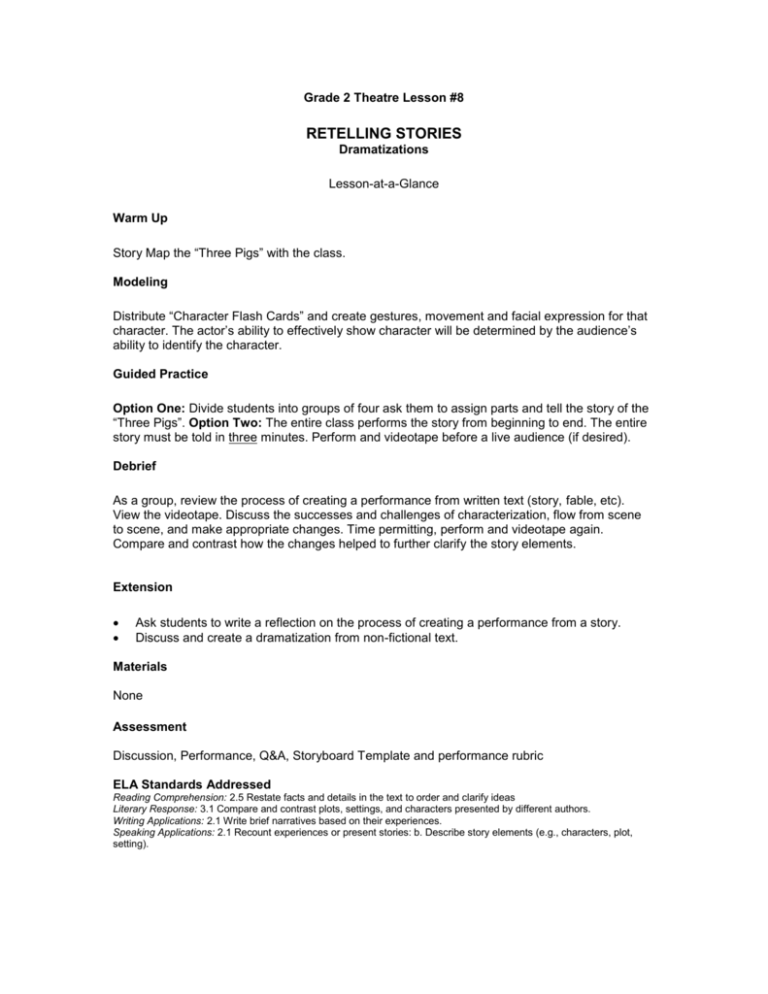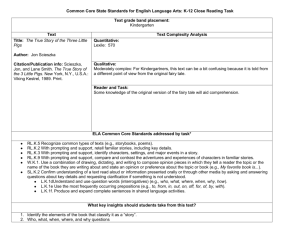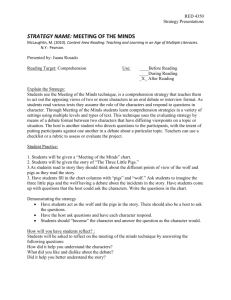THEATRE Grade 2 Lesson 8
advertisement

Grade 2 Theatre Lesson #8 RETELLING STORIES Dramatizations Lesson-at-a-Glance Warm Up Story Map the “Three Pigs” with the class. Modeling Distribute “Character Flash Cards” and create gestures, movement and facial expression for that character. The actor’s ability to effectively show character will be determined by the audience’s ability to identify the character. Guided Practice Option One: Divide students into groups of four ask them to assign parts and tell the story of the “Three Pigs”. Option Two: The entire class performs the story from beginning to end. The entire story must be told in three minutes. Perform and videotape before a live audience (if desired). Debrief As a group, review the process of creating a performance from written text (story, fable, etc). View the videotape. Discuss the successes and challenges of characterization, flow from scene to scene, and make appropriate changes. Time permitting, perform and videotape again. Compare and contrast how the changes helped to further clarify the story elements. Extension Ask students to write a reflection on the process of creating a performance from a story. Discuss and create a dramatization from non-fictional text. Materials None Assessment Discussion, Performance, Q&A, Storyboard Template and performance rubric ELA Standards Addressed Reading Comprehension: 2.5 Restate facts and details in the text to order and clarify ideas Literary Response: 3.1 Compare and contrast plots, settings, and characters presented by different authors. Writing Applications: 2.1 Write brief narratives based on their experiences. Speaking Applications: 2.1 Recount experiences or present stories: b. Describe story elements (e.g., characters, plot, setting). THEATRE – GRADE 2 RETELLING STORIES Dramatizations Lesson 6 CONTENT STANDARDS 2.2 Retell familiar stories, sequencing story points and identifying character, setting, and conflict. 4.1 Critique an actor’s performance as to the use of voice, gesture, facial expression, and movement to create character. TOPICAL QUESTIONS How do I show story elements through dramatization? How do I analyze a videotaped performance and make changes to better a performance? OBJECTIVES & STUDENT OUTCOMES Students will dramatize the elements of a story: setting, character, plot, conflict and resolution from a story map. Students will discuss and assess own performance and discuss improvements for performance. ASSESSMENT (Various strategies to evaluate effectiveness of instruction and student learning) Feedback for Teacher o Performance Rubric (included) o Performance Checklist (included) o Student response to inquiry o Student performance Feedback for Student o Teacher feedback o Performance Checklist and Rubric WORDS TO KNOW actor: a person, male or female, who performs a role in a play or an entertainment characterization: Development and portrayal of a personality through thought, action, dialogue, costuming, and makeup dramatization: an adaptation of a work of fiction or a presentation of a real event that is intended for performance on the stage, television, or radio setting: the location or place in which a story takes place plot: structure of a play, beginning, middle or end, conflict, resolution scene: a part of a play MATERIALS Refer to Story map, Storyboard and Character Analysis from previous lessons RESOURCES SDUSD VAPA Core Learnings WARM UP (Engage students, access prior learning, review, hook or activity to focus the student for learning) Create gestures, movement and facial expression for a variety of characters Each student selects a character card (don’t let anyone see your card!). Give students about 15 seconds to think about how this character would move and present themselves. Arrange students into four or five groups. Each group takes a turn performing while the rest of the class watches. When the word action is said, the first group moves silently around the room acting like the character card chosen. Allow 30 seconds of demonstrating. Stop action by using the word freeze and ask the audience who the characters were and how they knew (give details about how the character moved). (Suggestion: audience only has three chances to guess the character. If the character is not guessed, then the actor will share who their character was.) Ask the audience “What could the actor have done to make that character more clear?” Repeat until all groups have had a chance to perform. Option: Allow students to speak suitable lines or use vocal sounds. MODELING (Presentation of new material, demonstration of the process, direct instruction) Dramatizing the “Three Little Pigs” Small group modeling o Select a group of students (or ask for volunteers) Large group modeling Option 1: split the class into 4 larger groups, each group will play one of the characters Option 2: students can also play the part of the walls of the three houses. This means each scene could have at least six (6) actors – 1 pig, 1 wolf, and 4 actors each portraying one of the walls Begin rehearsal process o Assign parts o Discuss the plot and scenes in the story and how they will get the story across to the audience. o How will the problem and solution be shown? o Discuss characterization. What actions, facial expressions, etc. will each character use? What are the characters thinking? o Discuss and choose one costume piece or prop that defines the character. o Create simple dialogue and sound effects as appropriate for each scene. What words would the actors speak in each scene and how will they be spoken? (Note: Students may improvise key words and phrases from the story’s text dialogue.). o Remember to move into and out of tableau with pantomime. Then add dialogue, scene by scene. o Create an entrance (or opening tableau) and exit (or ending tableau) and rehearse the story in its entirety. Model how to rehearse the story from beginning to end. GUIDED PRACTICE (Application of knowledge, problem solving, corrective feedback) Note: The preparation and performance will take approximately 2 sessions to complete. Option One: Divide students into groups of four ask them to assign parts and tell the story of the “Three Pigs”. Option Two: The entire class performs the story from beginning to end. You may add a narrator. Tell students o The entire story must be told in three minutes. o If doing small groups, each group should rehearse the story at least five times before performing. Perform and videotape before a live audience (if desired). DEBRIEF AND EVALUATE (Identify problems encountered, ask and answer questions, discuss solutions and learning that took place. Did students meet expected outcomes?) Review the process of creating a performance from written text (story, fable, etc). View the videotape Discuss the successes and challenges of the following: o Actor’s use of voice, facial expression and movement and gesture to create mood and character. o What could the actor do to make the character every more defined? o As suggestions are made, allow students to get up and try making the changes. Compare and contrast the performance on the video with the changes that were made. o How do the changes make the performance even better? Time permitting, perform and videotape again. Compare and contrast how the changes helped to further clarify the story elements. EXTENSION (Expectations created by the teacher that encourages students to participate in further research, make connections and apply understanding and skills previously learned to personal experiences.) Ask students to write a reflection on the process of creating a performance from a story. Discuss and create a dramatization from non-fictional text. Performance Rubric 4 Advanced: Group/actor gesture, movement from scene to scene, facial expression and voice is clear and exaggerated. Characters, scenes, problem and solution are clearly defined. 3 Proficient: Group/actor gesture, movement from scene to scene, facial expression and voice is sufficient to identify the characters, scenes, problem and solution. 2 Basic: Group/actor displays difficulty defining character, movement from scene to scene, voice and facial expression. Group needs coaching and can make corrections as guided. 1 Approaching: Group/actors cannot express character with face and body without assistance. Story is not identifiable. Name/Group No. Performance Comments 4 3 2 1 4 3 2 1 4 3 2 1 4 3 2 1 4 3 2 1 4 3 2 1 4 3 2 1 4 3 2 1 4 3 2 1 4 3 2 1 Performance Checklist Circle Y or N if actor or whole group effectively employed the dramatic elements. Name/Group No. Gesture Movement Voice Y Y Y N N N Facial Expression Y N Costume or Prop Y N Notes: Notes: Notes: Notes: Notes: Y Y Y Y Y N N N N N Notes: Notes: Notes: Notes: Notes: Y Y Y Y Y N N N N N Notes: Notes: Notes: Notes: Notes: Y Y Y Y Y N N N N N Notes: Notes: Notes: Notes: Notes: Y Y Y Y Y N N N N N Notes: Notes: Notes: Notes: Notes: Y Y Y Y Y N N N N N Notes: Notes: Notes: Notes: Notes: Y Y Y Y Y N N N N N Notes: Notes: Notes: Notes: Notes: Y Y Y Y Y N N N N N Notes: Notes: Notes: Notes: Notes: Y Y Y Y Y N Notes: N Notes: N Notes: N Notes: N Notes: Character Card Illustrations King Secret Agent Cowboy Queen Super Hero Police Officer Karate Expert Movie Star Baby Clown Fire Fighter Rock Star Baseball Player Robot Doctor Soccer Player Football Player Dancer Spaceman Artist Soldier Villain Tightrope Walker Fisherman Three Little Pigs Once upon a time there were 3 little pigs. These little pigs lived happily in a house they had built out of straw. One day a big bad wolf came along and saw the three little pigs playing outside their house. He was very hungry, and he wanted a tasty ham sandwich. So he chased those pigs and they ran inside and they locked the door. And along came the wolf, and he banged on the door. BANG BANG BANG. And he said, “Little pigs, little pigs, let me come in” and they said, “Not by the hair on our chinny chin chins”. And the wolf said, “Then I’ll huff, and I’ll puff, and I’ll blow your house down.” And he did. The piggies squealed in terror and the ran down the road to a twig house. They ran inside and locked the door, and the wolf tried again. He said, “Little pigs, little pigs, let me come in” and they said, “Not by the hair on our chinny chin chins”. And the wolf said, “Then I’ll huff, and I’ll puff, and I’ll blow your house down.” And he did. The pigs ran to a house made out of bricks and the wolf tried again. He said, “Little pigs, little pigs, let me come in” and they said, “Not by the hair on our chinny chin chins”. And the wolf said, “Then I’ll huff, and I’ll puff, and I’ll blow your house down.” The wolf hugged, and he puffed, still the house did not move. So the wolf decided to climb up onto the roof to slide down the chimney. The pigs heard the wolf, the pigs built a fire, the wolf slid down the chimney, landed right on his bottom, and howled in pain. He ran out the door, and that was the end of the big bad wolf. Call out “Group one, scene one (clap) 3,2,1 freeze” Group 1 Scene 1: Wolf banging on door / 3 scared pigs Scene 2: Wolf breaking door / pigs running Group 2 Scene 1: Wolf banging on door / 3 pigs teasing wolf Scene 2: Wolf breaking door/ 3 pigs on floor scared Group 3 Scene 1: Wolf blowing / 3 pigs building the fire. Scene 2: Wolf climbing / 3 pigs look up scared Group 4 Scene 1: 3 pigs teasing wolf / wolf running Scene 2: Wolf mad / 3 pigs laughing






